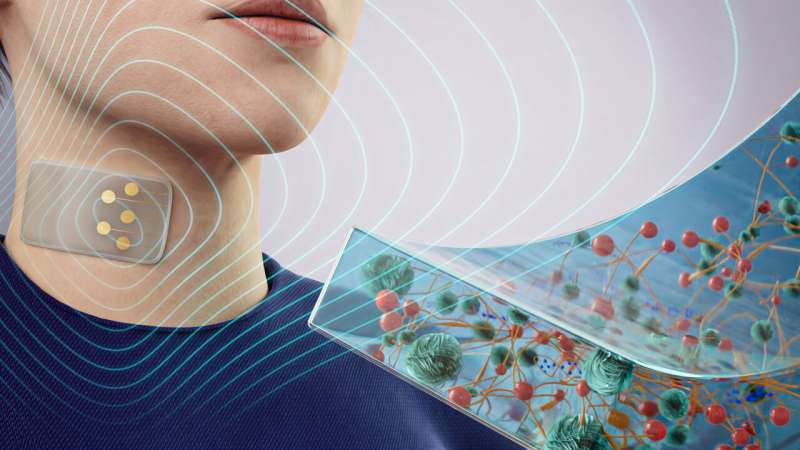
With greater than 1,000 nerve endings, human pores and skin is the mind’s largest sensory connection to the surface world, offering a wealth of suggestions by contact, temperature and stress. Whereas these advanced options make pores and skin an important organ, additionally they make it a problem to copy.
By using nanoengineered hydrogels that exhibit tunable digital and thermal biosensing capabilities, researchers at Texas A&M College have developed a 3D-printed digital pores and skin (E-skin) that may flex, stretch and sense like human pores and skin.
“The power to copy the sense of contact and combine it into numerous applied sciences opens up new potentialities for human-machine interplay and superior sensory experiences,” stated Dr. Akhilesh Gaharwar, professor and director of analysis for the Division of Biomedical Engineering. “It could possibly probably revolutionize industries and enhance the standard of life for people with disabilities.”
Future makes use of for the E-skin are huge, together with wearable well being gadgets that repeatedly monitor important indicators like movement, temperature, coronary heart charge and blood stress, offering suggestions to customers and serving to them enhance their motor expertise and coordination.
“The inspiration behind creating E-skin is rooted within the want to create extra superior and versatile interfaces between know-how, the human physique and the setting,” Gaharwar stated. “Essentially the most thrilling facet of this analysis is its potential functions in robotics, prosthetics, wearable know-how, sports activities and health, safety methods and leisure gadgets.”
The E-skin know-how, detailed in a research printed by Superior Practical Supplies, was developed in Gaharwar’s lab. Drs. Kaivalya Deo, a former scholar of Gaharwar and now a scientist at Axent Biosciences, and Shounak Roy, a former Fulbright Nehru doctoral fellow in Gaharwar’s Lab, are the paper’s lead authors.
Creating E-skin entails challenges with creating sturdy supplies that may concurrently mimic the pliability of human pores and skin, comprise bioelectrical sensing capabilities and make use of fabrication methods appropriate for wearable or implantable gadgets.
“Prior to now, the stiffness of those methods was too excessive for our physique tissues, stopping sign transduction and creating mechanical mismatch on the biotic-abiotic interface,” Deo stated. “We launched a ‘triple-crosslinking’ technique to the hydrogel-based system, which allowed us to handle one of many key limitations within the subject of versatile bioelectronics.”
Utilizing nanoengineered hydrogels addresses a few of the difficult elements of E-skin growth throughout 3D printing attributable to hydrogels’ capacity to lower viscosity beneath shear stress throughout E-skin creation, permitting for simpler dealing with and manipulation. The staff stated this characteristic facilitates the development of advanced 2D and 3D digital buildings, a necessary facet of replicating the multifaceted nature of human pores and skin.
The researchers additionally utilized ‘atomic defect’ in molybdenum disulfide nano-assemblies, a cloth containing imperfections in its atomic construction that enable for prime electrical conductivity, and polydopamine nanoparticles to assist the E-skin stick with moist tissue.
“These specifically designed molybdenum disulfide nanoparticles acted as crosslinkers to kind the hydrogel and imparted electrical and thermal conductivity to the E-skin; we’re the primary to report utilizing this as the important thing element,” Roy stated. “The fabric’s capacity for adhesion to moist tissues is especially essential for potential well being care functions the place the E-skin wants to adapt and cling to dynamic, moist organic surfaces.”
Different collaborators embrace researchers from Dr. Limei Tian’s group within the biomedical engineering division at Texas A&M and Dr. Amit Jaiswal on the Indian Institute of Know-how, Mandi.
Extra data:
Shounak Roy et al, 3D Printed Digital Pores and skin for Pressure, Strain and Temperature Sensing, Superior Practical Supplies (2024). DOI: 10.1002/adfm.202313575
Texas A&M College Faculty of Engineering
Quotation:
3D printed digital pores and skin supplies promise for human-machine interplay (2024, January 26)
retrieved 27 January 2024
from https://techxplore.com/information/2024-01-3d-electronic-skin-human-machine.html
This doc is topic to copyright. Other than any honest dealing for the aim of personal research or analysis, no
half could also be reproduced with out the written permission. The content material is supplied for data functions solely.
